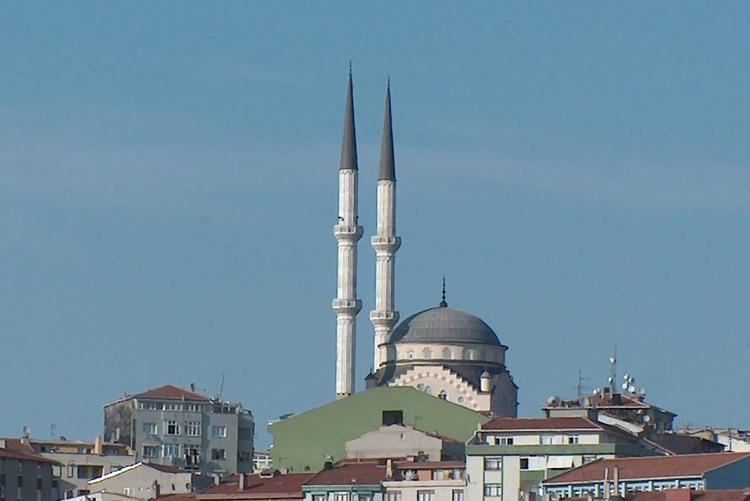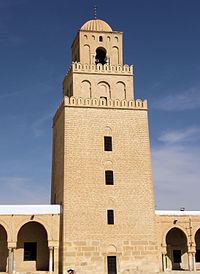 | ||
Similar Sultan Ahmed Mosque, Hagia Sophia, Qutb Minar, Kaaba, Koutoubia Mosque | ||
Muslim prayer from minaret
A minaret (/ˌmɪnəˈrɛt, ˈmɪnəˌrɛt/; Persian: مناره menare, Turkish: minare,), from Arabic: منارة manāra, lit. "lighthouse", also known as Goldaste (Persian: گلدسته), is a distinctive architectural structure akin to a tower and typically found adjacent to mosques. Generally a tall spire with a conical or onion-shaped crown, usually either free-standing or taller than associated support structure. The basic form of a minaret includes a base, shaft, and gallery. Styles vary regionally and by period. Minarets provide a visual focal point and are traditionally used for the Muslim call to prayer.
Contents

Eger minaret muezzin
Functions

The purpose of minarets in traditional Eastern region architecture is to serve as a ventilation system for a building in very hot climates. Usually, the building would consist of a tower with large open windows that would allow for cold air to enter, and a dome in the center of the building that would (hypothetically) have an opening in the ceiling that would both accumulate and allow warm air to leave the building through a cupola. That buildings of middle eastern origins have such outstanding features is architecturally intentional. Mosques usually have a center hall room with a raised ceiling or dome to allow for heat to accumulate and rise upwards leaving the cold air on the lower floor allowing for a system of natural air conditioning.

However in modern times, with the invention of the modern air conditioners, the purpose of minarets has changed to traditional symbol. The minaret would be equipped with a speaker that would call people to prayers in Muslim countries. In addition to providing a visual cue to a Muslim community, the main function at present is to provide a vantage point from which the call to prayer, or adhan, is made. The call to prayer is issued five times each day: dawn, noon, mid-afternoon, sunset, and night. In most modern mosques, the adhān is called from the musallah (prayer hall) via microphone to a speaker system on the minaret.
History

The earliest mosques lacked minarets, and the call to prayer was performed elsewhere; hadiths relay that the Muslim community of Medina gave the call to prayer from the roof of the house of Muhammad, which doubled as a place for prayer. Around 80 years after Muhammad's death, the first known minarets appeared.

Minarets have been described as the "gate from heaven and earth", and as the Arabic language letter aleph (which is a straight vertical line).

The massive minaret of the Great Mosque of Kairouan in Tunisia is the oldest standing minaret. Its construction began during the first third of the 8th century and was completed in 836 CE. The imposing square-plan tower consists of three sections of decreasing size reaching 31.5 meters. Considered as the prototype for minarets of the western Islamic world, it served as a model for many later minarets.
The tallest minaret, at 210 metres (689 ft) is located at the Hassan II Mosque in Casablanca, Morocco. The tallest brick minaret is Qutub Minar located in Delhi, India.
In some of the oldest mosques, such as the Great Mosque of Damascus, minarets originally served as illuminated watchtowers (hence the derivation of the word from the Arabic nur, meaning "light").
Construction
The basic form of minarets consists of three parts: a base, shaft, and a gallery. For the base, the ground is excavated until a hard foundation is reached. Gravel and other supporting materials may be used as a foundation; it is unusual for the minaret to be built directly upon ground-level soil. Minarets may be conical (tapering), square, cylindrical, or polygonal (faceted). Stairs circle the shaft in a counter-clockwise fashion, providing necessary structural support to the highly elongated shaft. The gallery is a balcony that encircles the upper sections from which the muezzin may give the call to prayer. It is covered by a roof-like canopy and adorned with ornamentation, such as decorative brick and tile work, cornices, arches and inscriptions, with the transition from the shaft to the gallery typically sporting muqarnas.
Local styles
Styles and architecture can vary widely according to region and time period. Here are a few styles and the localities from which they derive:
